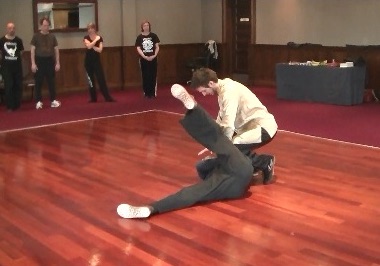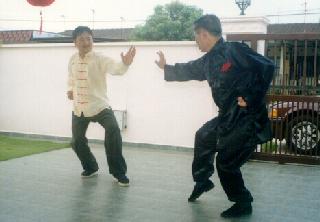KUNGFU NOW AND IN THE PAST

Any kungfu is for combat
Question
I have been studying kungfu for about 1 1/2 years. My master informed me that I would not be able to spar for about 7 years until I had learnt most of the style.
Adam, UK
Answer
Kungfu is a martial art. If one has to spend seven years learning the form before he learns sparring, the art or the method of teaching it is grossly ineffective. The phrase “until I had learnt most of the style” suggests that the repertoire of this style, or of the teacher, consists chiefly of kungfu sets.
Little of the repertoire is devoted to sparring, and perhaps nothing is devoted to force training. This in fact is the norm in most kungfu schools today, where haphazard free sparring and crude weight training are innovations by enterprising students borrowing methods from karate and weight-lifting.
If you examine classical kungfu literature recording how kungfu was practised in the past, you would find that set practice, i.e. learning kungfu form, constituted only a small part of the training programme. For an exponent who had spent 10 years in kungfu training, the first year would be spent on learning kungfu form, and the remaining nine years on force training and sparring.
Question
Do you think this would help in the area of sparring? Would this enable me to learn so much about the style and its applications that I should have better knowledge of using them whilst free sparring, and not reverting to any form of Karate, Taekwondo or Kickboxing?
Answer
No, this would not help you in sparring. I think that after seven years, or even after 25 years, even when you have learnt so much about the style and its application (in theory), you would spar like children. If you spar with a blue-belt in karate or taekwondo, or with a novice in kickboxing, you would be punched and kicked all over by him. This is actually the case with most so-called kungfu or wushu students today, although these students could perform routine kungfu sets beautifully.
Why? The reason is simple. The blue-belts or kickboxing novices have practised sparring for a few months, the kungfu or wushu students have no sparring practice at all.
If these kungfu or wushu students suggest to their teacher to have sparring practice, the teacher might say that Chinese kungfu is very deadly and thus sparring is dangerous. If they enquire how they could learn self-defence without sparring practice, he might say that after practising for “ten years or eight years” they could fight.
All this, of course, is not true. Practised correctly, kungfu sparring is safe. There are far more injuries resulting from sparring in karate, taekwondo and kickboxing than in kungfu, even with weapons. In sparring in most other martial arts, students exchange punches and kicks freely; in kungfu they are not supposed to be hit even once.
Question
Also, would studying Shaolin Kung-Fu be easier or more enjoyable if it is learnt in the country it originated from? I have always had a dream of learning in the Shaolin Temple amongst the monks. Would my not being Chinese shatter my dream?
Answer
Practising genuine Shaolin Kungfu — in China, the United Kingdom, Sudan or anywhere in the world — is never easy. First, finding a genuine Shaolin master who is willing to teach you, is very difficult. The actual practice itself is very hard work. But the rewards are tremendous. A saying in Chinese (Cantonese) reads as follows:
- hok tak sil lam chen miu fatt
- hou pei tim seak pin kam juin
It means
- Being successfully trained in genuine Shaolin arts
- Is better than having the magic touch to change stones to gold
Most people would think the expression an exaggeration. Personally I can vouch for the truth of this expression. If you appreciate that genuine Shaolin training actualize your full potential — in all your physical, emotional, mental and spiritual dimensions — you may appreciate that it is better than becoming fabulously wealthy.
I think it is more difficult and less enjoyable to learn genuine Shaolin Kungfu in China. It is very difficult to find genuine Shaolin masters even in China, and even if you can find one he is not likely to teach you, especially when you are unfamiliar with traditional master-student relationship, and think that learning from a master is doing him a favour, or that it is his duty to teach any Tom, Dick and Harry if they desire to learn.
If you had the unbelievable luck to learn from a genuine Shaolin master in China, you would find your learning less enjoyable than, say, in the United Kingdom. For example, you would not drive to his apartment, say “Hi, good morning,” then have tea served by him, before starting your morning training.
Instead you would have to track half a mile to his humble shed, prostrate before him in a customary way, rush to a nearby stream to bring back two pots of water which you would carry using your tiger-claws, boil the water and serve him tea, then practise your Horse-Riding Stance with the two pots on your thighs, while he slowly sips tea and admires the sky, perhaps with a cane in his hand, ready to whack you if the pots fall.
But you won't get such treatment at the Shaolin Temple today. Traditional Shaolin Kungfu is not taught in the Temple nowadays. But you can register yourself with any of the numerous schools around the Temple. These schools also do not teach traditional Shaolin Kungfu, but they teach wushu, a modernized form of kungfu promoted as sport. The instructors often wear monks' robes.
As the Shaolin Temple today does not teach Shaolin Kungfu, whether your being non-Chinese is a hindrance, becomes an irrelevant question. But in the past, although the Shaolin Temple was, and still is, Buddhist, one's race and religion did not make any difference.

Being successfully trained in genuine Shaolin arts is better than having the magic touch to change stones to gold
The above is taken from Question 7, 8 and 9 of June 1901 Part 1 of the Selection of Questions and Answers.
LINKS
Courses and Classes
